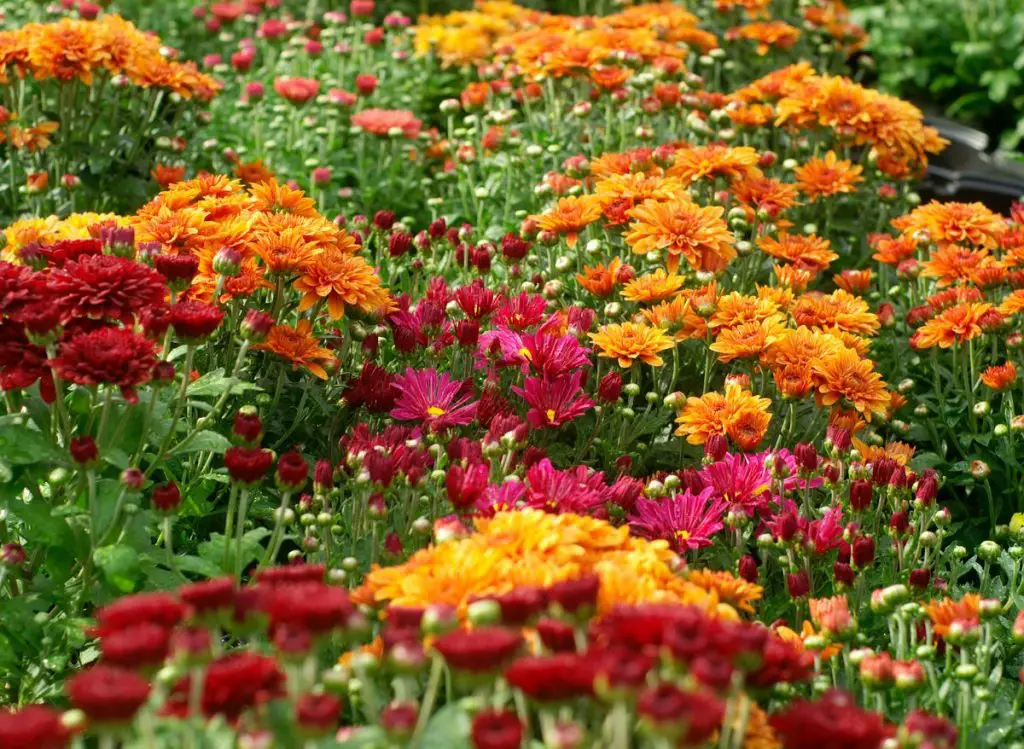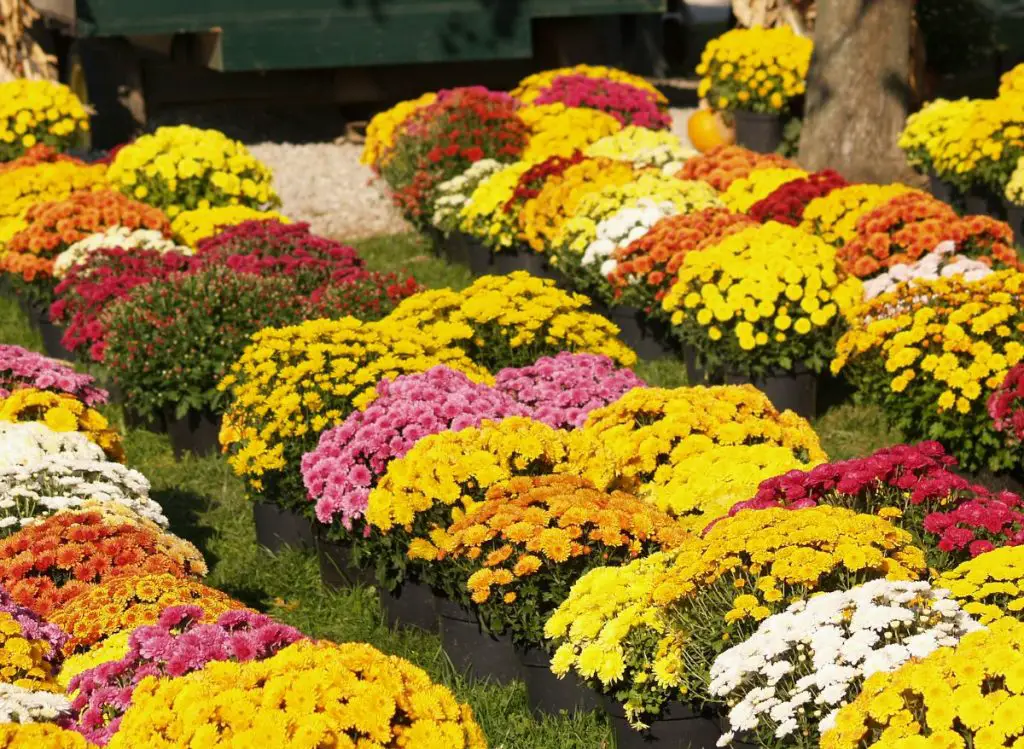
Chrysanthemums, also called mums or chrysanths, are flowering plants of the genus Chrysanthemum member of the family Asteraceae.
Growing and caring for mum plants can be tricky if done improperly. Their growth requirements depend on where they are grown. Most growers often wonder: are mums indoor or outdoor plants?
Mums are generally outdoor plants where they can live year-round. For optimal results, use a 5-to-6-inch pot and keep mum plants well watered with temperatures close to 60 degrees Fahrenheit. When new sprouts appear, move them to full sun and give them plenty of water (Source: University of Missouri)
Mums are classic houseplants that are usually brought as a present at Christmas, Easter, or Mothering Sunday. In some parts of the world, people gift mums as a symbol of motherhood, for instance, shortly after a woman gives birth.
Read on to learn everything you need to know to grow properly and care for mums, including the different types of mums.
You might also enjoy reading: Will Frost Hurt Your Mums? Here’s The Truth!
Are Mums Indoor Or Outdoor Plants?
Mums thrive outdoors. It is recommended to keep mum plants outdoors as long as possible in the fall. When light frost threatens, cover your plants, lift the pots, and bring them indoors. During cold, freezing temperatures, you can bring mum plants indoors.
I suggest you place your plants in a sunny south window with temperatures around 60 degrees Fahrenheit at night and between 70 to 75 degrees Fahrenheit during Day time.
In addition, hardy garden mums thrive in pots and are suitable for outdoor planting. Put them out in a sunny, well-drained spot when the ground is warm in spring.
See also: Top 6 Indoor Plants that Clean the Air and Remove Toxins.
How Do You Know If Your Mums Are Perennial Or Annual?
The annual variety is Chrysanthemum multicaule, and the perennial, fall-flowering form is Chrysanthemum x morifolium. If you can’t identify your plant, remember that the annual mums have thinner, strappy leaves that are not as toothed as the perennials, which are wide and a little notched.
Garden mums, also referred to as hardy mums, are perennial mums and are easier to find for sale online. And most mums sold in garden centers and nurseries are annuals, especially in growing zones 1 to 4.
Hardy chrysanthemums are generally easy-to-grow perennials; unlike other chrysanthemums grown as annuals, perennials mums return year after year, even in colder climates.
Mums Growth Requirements
Mums are perennials, hardy in U.S. Department of Agriculture (USDA) plant hardiness zones 5 through 10, and they grow 6 to 24 inches (15.24 to 60.96 cm) tall and wide.
As houseplants, mums are loved for their ability to purify the air of pollutants. You successfully grow mums and extend their lifespan by learning mum’s growth requirements.
The table below shows an overview of Chrysanthemums (mums)
| Scientific Name | Chrysanthemum |
| Family | Asteraceae |
| Life Cycle | Perennial |
| Plant Type | – Ground Cover – Perennial – Herbaceous Perennial |
| Common Names | – Mums – Chrysanths |
| Flower Color | – Pink – Cream (Tan) – Gold (Yellow) – White – Purple (Lavender) – Red (Burgundy) |
| Light Requirements | – Mums generally thrive in dappled sunlight or shade via an upper canopy throughout the day. – Mums also do well in full sun with at least 6 hours of direct sunlight per day – Put your plant mums near a window that receives bright light but no direct sun. |
| pH Requirements | The ideal pH for mums is between 6.5 to 7.0, but they will tolerate slightly alkaline or slightly acidic soil. |
| Temperature Requirement | – Night: Keep your plant at temperatures between 60 and 65 degrees Fahrenheit – Daytime: temperatures about 10 to 15 degrees higher. |
| Mums Soil Requirements | Mums prefer rich and moist soil with good drainage |
| Watering requirements | Keep your soil moist but not too wet. Avoid allowing the soil to dry out. Allow the top inch of the soil to dry out between waterings. |
| Flower Bloom Time | – Fall – Summer |
| Mums Maintenance Requirement | Medium |
| Fertilizer Requirements | Regularly feed during the vegetative stage with nitrogen and potassium-rich organic fertilizer. |
| Propagation | The best method to propagate Chrysanthemum is by division or stem cutting. |
| Pests And Diseases | The most common problem growing mums is leaf blight; however, garden mums are generally pest tolerant and have few pests of significant concern (Source: The University of Florida) |
| USDA Plant Hardiness Zone | 4 to 8 |
Caring For Mums
Whether you are getting your mums inside your home or outdoors, if you want their blooms to last longer, choose ones where the flowers haven’t opened.
Tips For Growing And Caring For Mums:
- It is best to plant mums in early spring in full sun with moist, rich, well-drained soil.
- When planting mums in the fall, ensure you remove all the flowers to encourage root growth and cover them with thick mulch.
- Good soil drainage is essential for overwintering roots.
- Without sufficient light, mums might survive but thin out; their stems will become long and floppy, affecting their appearance.
- To encourage branching and flower bud production, pinch the stems or shear the plant as soon as the buds appear in the spring.
- You might need to prune during summer if the plant becomes leggy, but ensure to leave the stems on the plant to keep the crown protected over the winter.
- You use stem cuttings to propagate the plant about once a year.
- You can also use division in the spring to avoid dieback in the center of your mum plant.
- Check each day to ensure that the soil is moist. Do not let the plant wilt, and avoid keeping the pot sitting in water.
See also: Are Belgian Mums Annual or Perennial? (Let’s find out!)

What Are The Different Types Of Mums?
Chrysanthemums (or mums) are available with many variations in flower color, growth habit, and flower form.
Here are a few popular types of mums your favorite florist might have in stock for this Mother’s Day.
The table below shows the different types of mums
| Types Of Mums | Characteristics | Examples |
| Cushion Mums | Cushion mums are bushy, low-growing plants that produce abundant mid-sized blooms. | Chiffon, Ruby Mound, and Valour are examples of Cushion mums. |
| Anemone Mums | Anemone mums have darker petals that contrast with the radiating daisy-like petals. | Mansetta Sunset and Daybreak are examples of anemone mums. |
| Spoon Mums | Spoon mums are easily recognized by the long, spoon-like petals that shine from the center. | Starlet and Happy Face are examples of spoon mums. |
| Decorative Mums | Decorative mums are short plants and big, splashy blooms with many rows of full, curved petals. | Tobago and Indian Summer are examples of Decorative mums. |
| Quill Mums | Quill mums have long, straight, tube-shaped petals, require extra care, and can survive cold temperatures. It is usually grown as an annual. | Matchsticks and Muted Sunshine are examples of quill mums. |
| Spider Mums | Spider mums come with long, curling petals that look like spiders sitting on top of stems; spider mums are among the more unusual chrysanthemum plant varieties. | Anastasia and Cremon are examples of Spider mums. |
| Single chrysanthemums | Single chrysanthemums are characterized by a flat center and up to five radiating rows of long, daisy-like petals. Single chrysanthemums are also one of the most common varieties of mums with a distinct aroma when crushed. | Amber Morning, Daisy, and Tenderness are examples of Single chrysanthemums. |
| Pompom Mums | Pompom mums offer many colorful little globe-like blooms per stem. The smallest pompom mums are named button mums. | Moonbeam and Pixie are examples of pompom mums. |
Final Thoughts
Chrysanthemums (mums) are typically outdoor plants where that can live year-round. Adding mums to your garden can elevate its beauty as they symbolize longevity, fidelity, joy, and optimism. There are so many mums, about 20,000 varieties, and I believe there is a mum for everyone.
What to read next:

